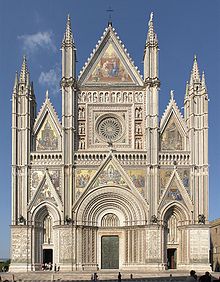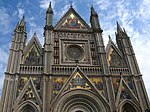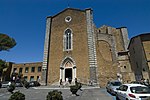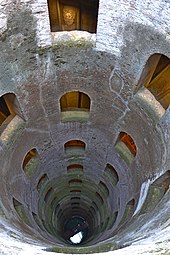Orvieto
| Orvieto | ||
|---|---|---|

|
|
|
| Country | Italy | |
| region | Umbria | |
| province | Terni (TR) | |
| Coordinates | 42 ° 43 ' N , 12 ° 6' E | |
| height | 325 m slm | |
| surface | 281 km² | |
| Residents | 20,290 (Dec. 31, 2019) | |
| Population density | 72 inhabitants / km² | |
| Post Code | 05018 | |
| prefix | 0763 | |
| ISTAT number | 055023 | |
| Popular name | Orvietani | |
| Patron saint | San Giuseppe (March 19) | |
| Website | Orvieto | |
 Panorama of Orvieto |
||
Orvieto is a town with 20,290 inhabitants (as of December 31, 2019) in southwest Umbria in the province of Terni in Italy .
geography
The entire old town is built on a rock plateau made of tuff rock . This city rock is criss-crossed by a labyrinth of cellars, corridors and huge cisterns , a small part of which has been re-opened for sightseeing (see: Orvieto Tuff Graves ). Numerous Etruscan graves arranged in rows of streets can be found directly below the city rock, and there were tombs with paintings on the slopes opposite the city.
history
It is believed that Orvieto ( Urbs Vetus "old city") is the medieval name and location of the Etruscan city of Velzna (Roman Volsinii ), one of the twelve federal capitals of the Etruscan Empire. However, this is not guaranteed.
Velzna was founded after a slave revolt in 264 BC. Chr. By Marcus Fulvius Flaccus conquered. The Romans forced the survivors to settle in a less fortified location in Volsinii Novi on Lake Bolsena , today's Bolsena .
Orvieto was temporarily the residence of the Popes of the Middle Ages. Clement VII had to flee here in 1527 after Rome was sacked in the Sacco di Roma .
During the Second World War there was a military airfield near Orvieto ( ⊙ ), on which the engineer Pier Luigi Nervi built a hangar that was unusual for the time , but which was destroyed during the war.
Orvieto itself was not destroyed in World War II, as the German Air Force officer Alfred Lersen, as city commander, handed Orvieto over to the Allies, who arrived on June 14, 1944, under the British Major Richard Heseltine as an open city .
Attractions
The sights include numerous palazzi from the Middle Ages and the Renaissance, e. B. the Palazzo del Capitano on the Piazza del Popolo, today a congress center, and the Orvieto funicular . The La Serpara sculpture garden is located in the surrounding hills of Orvieto .
Churches
- The Cathedral of Orvieto is the cathedral of the Diocese of Orvieto-Todi .
- Church of San Giovenale (1004)
- Chiesa di Sant'Andrea, built over the ruins of a pagan temple and an early Christian church
- Chiesa di San Domenico with the mausoleum of Cardinal Guillaume de Bray (e) by Arnolfo di Cambio
- Chiesa di San Ludovico
- Chiesa di San Francesco, XIII. century
- Abbazia di San Severo e Martirio, Romanesque monastery
Pozzo di San Patrizio
Another attraction is that of Antonio da Sangallo d. The Pozzo di San Patrizio fountain was built between 1527 and 1537 (depth 58.5 m, diameter 4.7 m).
Pope Clement VII had fled to Orvieto because of the siege of Rome by the troops of Charles V and wanted to protect himself from the consequences of another siege by ensuring that the city was supplied with water.
Sangallo came up with an ingenious plan: the paths to and from the fountain consist of two twisted spiral staircases . Because of this form of a double helix , the paths never cross, so that the donkeys with their loads of water could go down and up again without meeting each other.
Shortly after its completion in 1537, this fountain was rated as a special building and was visited by numerous architects.
The name of the building goes back to a legend according to which Christ is said to have shown St. Patrick a cave or pit that offers access to purgatory and thus convinced doubters of the existence of the torments of hell.
tourism
Orvieto lives from tourism. The city is a member of the Cittàslow , a movement founded in Italy in 1999 to slow down and increase the quality of life in cities through environmental policy, infrastructure policy, urban quality, appreciation of autochthonous products, hospitality, awareness and quality of the landscape.
Viticulture
Orvieto is also known as the namesake of the surrounding wine-growing region with the status of a Denominazione di origine controllata , DOC for short, known for the white Orvieto , which is offered in the flavors dry and sweet. A total of 1480 winemakers work 2,853 hectares of approved vineyards in the area surrounding the municipality of Orvieto.
sons and daughters of the town
- Francesco Ravizza (1615–1675), nuncio in Portugal
- Francesco Maria Pandolfi Alberici (1764–1835), cardinal
- Enrico Orfei (1800–1871), Archbishop of Ravenna and Cardinal
- Luigi Mancinelli (1848–1921), conductor and composer
- Lamberto Baldi (1895–1979), conductor and composer
- Mario Frustalupi (1942–1990), football player
- Stefano Tilli (* 1962), athlete
- Andrea Stella (* 1971), motorsport technician
literature
- Marcello Solini: The Orvieto Cathedral. Narni / Terni 1985.
- Stephan Steingräber and Giuseppe M. Della Fina (eds.): Orvieto. Verlag Philipp von Zabern, Mainz 2010, ISBN 978-3-8053-4072-4 .
Web links
- Orvieto - history, sights and personalities
- Illustration of the city in 1581 in Civitates orbis terrarum by Georg Braun (top picture)
- The Duomo and Orvieto underground
Individual evidence
- ↑ Statistiche demografiche ISTAT. Monthly population statistics of the Istituto Nazionale di Statistica , as of December 31 of 2019.
- ↑ Orvieto Military Airfield on forgottenairfields.com
- ^ Peter Anderson: German officer honored in Italy , Sächsische Zeitung, Meißen, May 20, 2020













